Once we get out of lockdown you might see me wearing this dress all the time! (actually probably not because by then I will have even more random and unnecessary new garments to wear :)

Here is the treasure that I found at a sewing guild stash sale. They often sell patterns for 25 cents so if I see any old Vogue designer patterns I snap them up, more for the fun of a vintage pattern than for any intention of sewing them. But this one I definitely knew I would sew up.
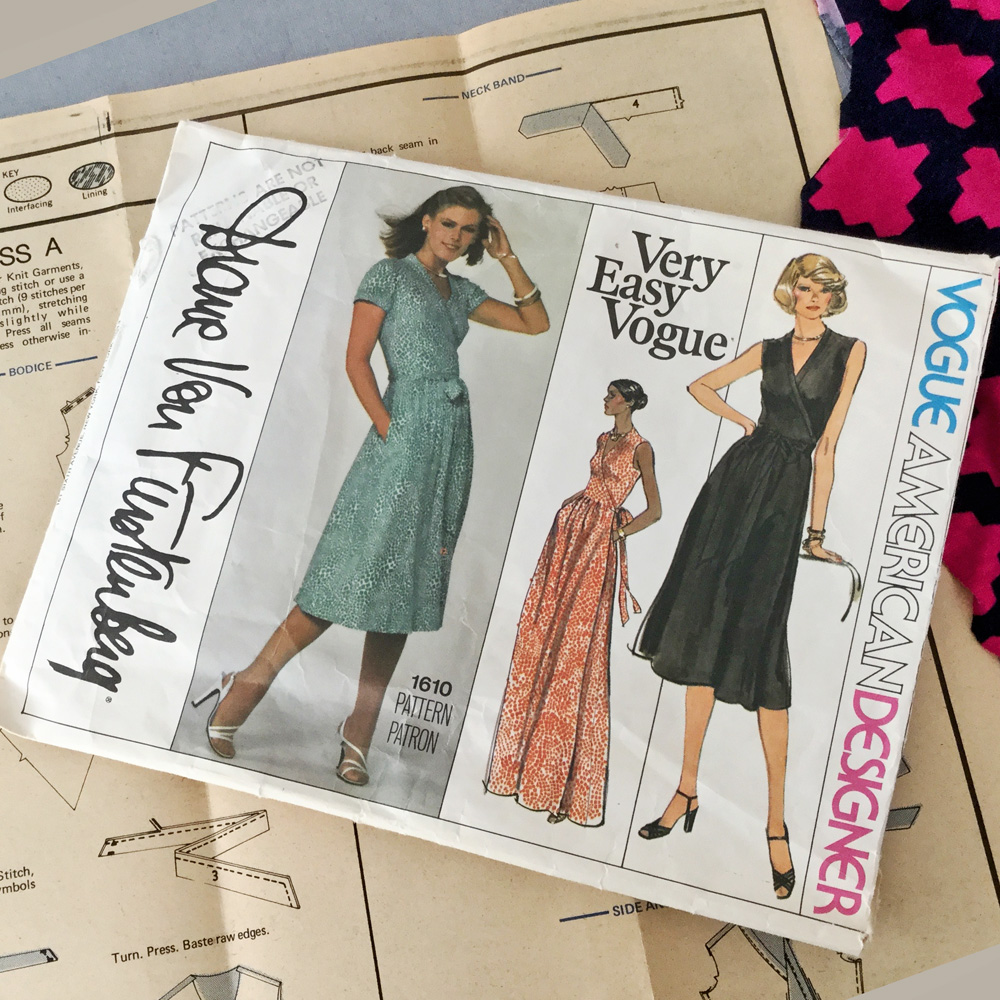
To me there is something delightful about these old Vogue American Designer patterns - they are just so casually chic and stylish. And look - this is a Very Easy Vogue, that's interesting that it was categorized as easy. According to the Vintage pattern Wiki its from Jan/Feb 1977. Vogue 1610 Diane Von Furstenberg wrap dress, for stretch knits only. Do you ever look at that Vintage pattern Wiki? lots of interesting stuff there.
And this is not THE DVF wrap dress, which is Vogue 1549 but this is a slightly different design, with a gathered skirt and a neck band with no collar.

This fabric is from Girl Charlee, they still have some in stock. I used another of their pink/navy knits for a top which I wear a lot.
Let's talk a little about fit, and knits now versus back in 1977. I think back then the knits were less stretchy, think of more like a cotton interlock and perhaps the fabrics were even only a single stretch direction (crossways grain) instead of the more common printed knits we find now which have 4 way stretch (and sometimes too much).
Check out the stretch guide at the bottom of the pattern envelope. It says the knit should stretch "to here only". I don't think I've seen that on a pattern recently but it explains the issue with this dress and using a 4-way stretch knit.
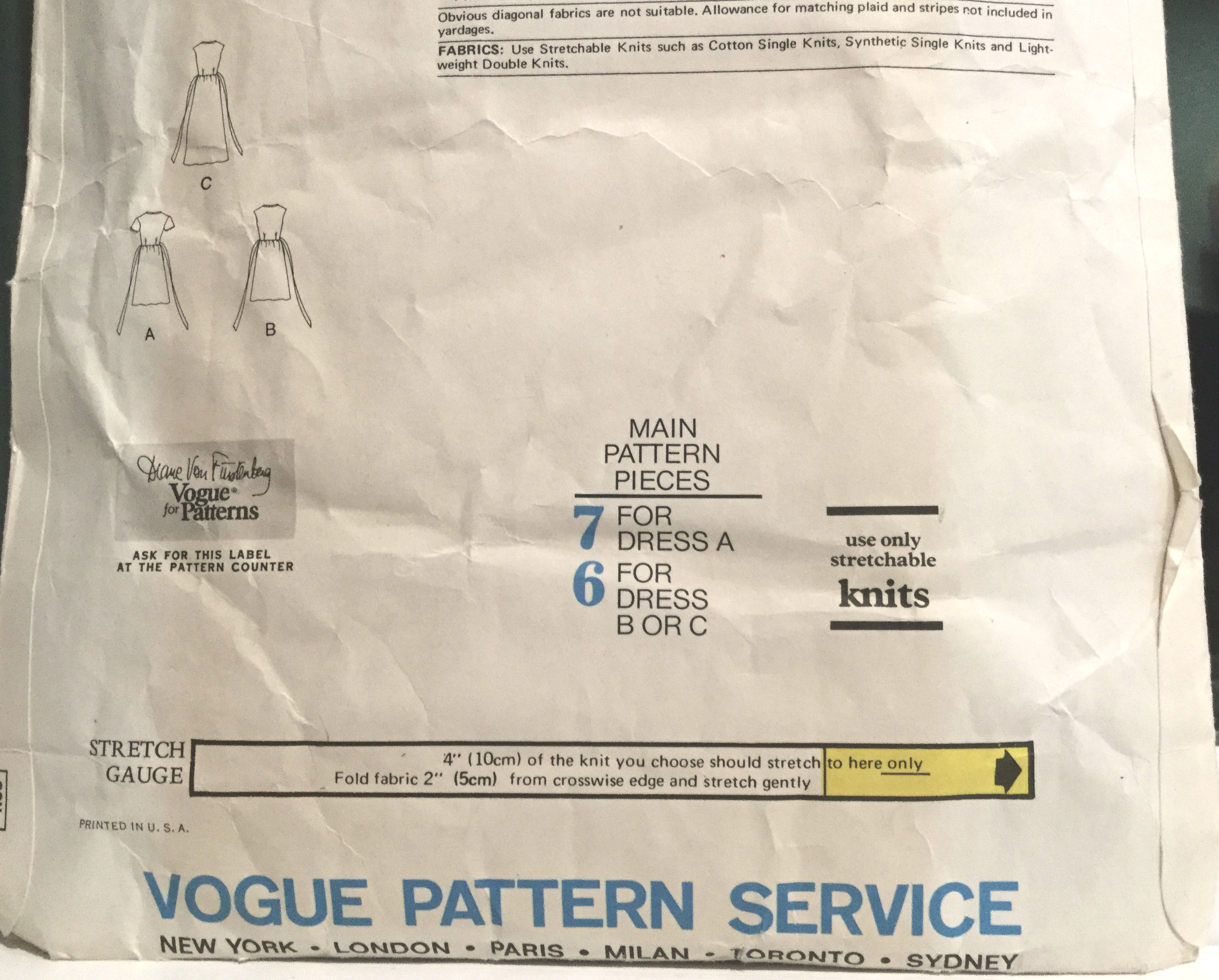
When I bought this pattern I wanted to make it up right away, and to try it out I bought some truly terrible knit fabric at Joann, on a super sale couple so the investment was minimal.
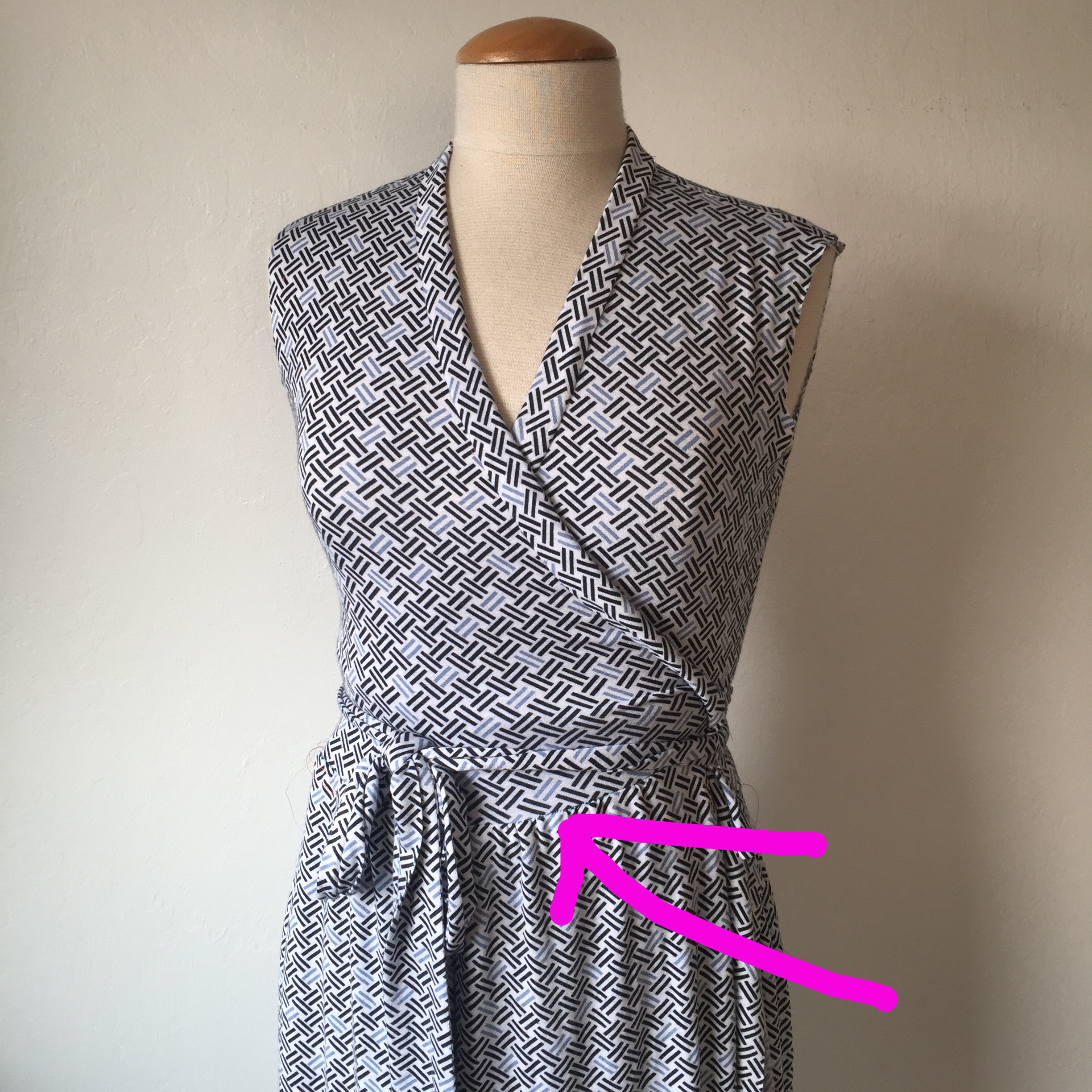
I sewed it up and you can see what happens on my dress form, the waist seam migrates downward due to the stretch of the fabric. It might not seem bad here but putting in on it was atrocious. Also this fabric had a weird fuzzy feel that made me dislike it even more. Out!
Flash forward to this year when I REALLY wanted the bright pink and navy fabric to work for this dress, and the answer as usual with knits is to line the bodice in a lightweight knit fabric with no lengthwise stretch. I've mentioned doing this before in other posts. The fabric I use to line knits is something I get at Joann's called Jet Set knit. I have no idea what it's for, I usually find it in the aisle with the dance wear knits. It comes in white, black, navy, beige although the stock is hit or miss. Also in purple as evidenced by my use of that color here. Which I found in my lining bin. Thank goodness for my lining bin which sometimes seems like Mary Poppins' travel bag as I seem to find all kind of magic in it which I have no recollection of putting in there. Note - when I go to fabric swaps or stash sales and I see some bargain which has lining potential I spend the $ 2 or $5 or whatever and stash it away. Look how useful these things are! (red coat with hot pink lining)
So the answer to the issue of too much length in the cotton jersey is to underline the front and back bodice with this stable lightweight knit fabric. Problem solved, the bodice now will not stretch from the weight of the skirt and the seam stays at the waist.
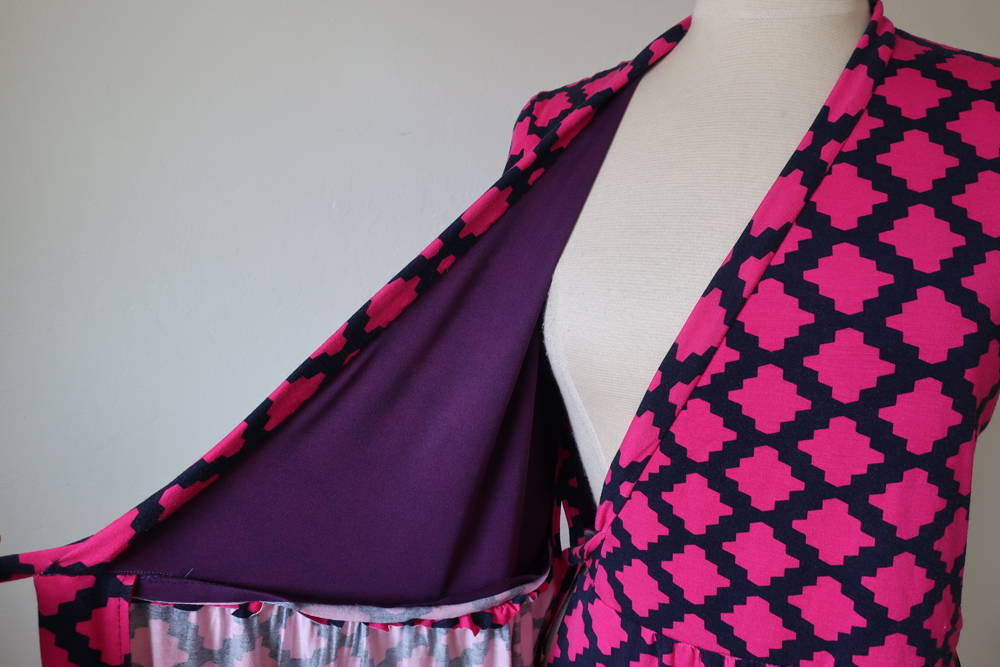
I treated the knit lining pieces and the bodice front and back as one, and only put the lining there, not in the sleeves. The goal was to change the degree of vertical stretch for the bodice pieces. I could tell that the bodice length was OK, it was just the stretch that was the problem.

To double check that I overlaid a pattern piece from a different knit wrap dress and saw that the length was very similar. I like the fit of that Butterick pattern so I determined that the Vogue would be fine if I could reduce the vertical stretch. Note that a number of the modern Vogue designer patterns I've sewn have lining in knit dresses, probably to control the stretch although some are to add a framework for the twisty details on the outer fabric, such as this dress.

Why the glass of wine? I finished this dress on the first weekend of the lockdown and posted this on my Instagram on April 4, for #virtualfrocktails. Looking back now I see that we were fortunate in the SF bay area to have had our Frocktails event in the end of Feb - which I almost missed due to having that nasty flu bug. But I will take that instead of this current virus.
Back to sewing details. Unusual for me I made almost no changes to this pattern, I think I shortened it by maybe 2 inches? and then once I finished it I thought the sleeves were just a tiny bit too long so I turned them up another 1/2".

As you can see in the photo with the wine glass, this dress does have pockets. Which are probably useless for putting anything into, since a pocket in a knit dress is going to be a bit saggy. But they are perfect for putting your hands in. Although they are maybe the tiniest pocket pattern pieces I've ever seen. For pockets in almost anything, if I'm going to use the fashion fabric for the back pocket piece I like to use some lining fabric for the front, so that as the pocket bag lays against the front skirt it is slippery and doesn't stick to the outer fabric. Not the cutest picture below but you get the idea.
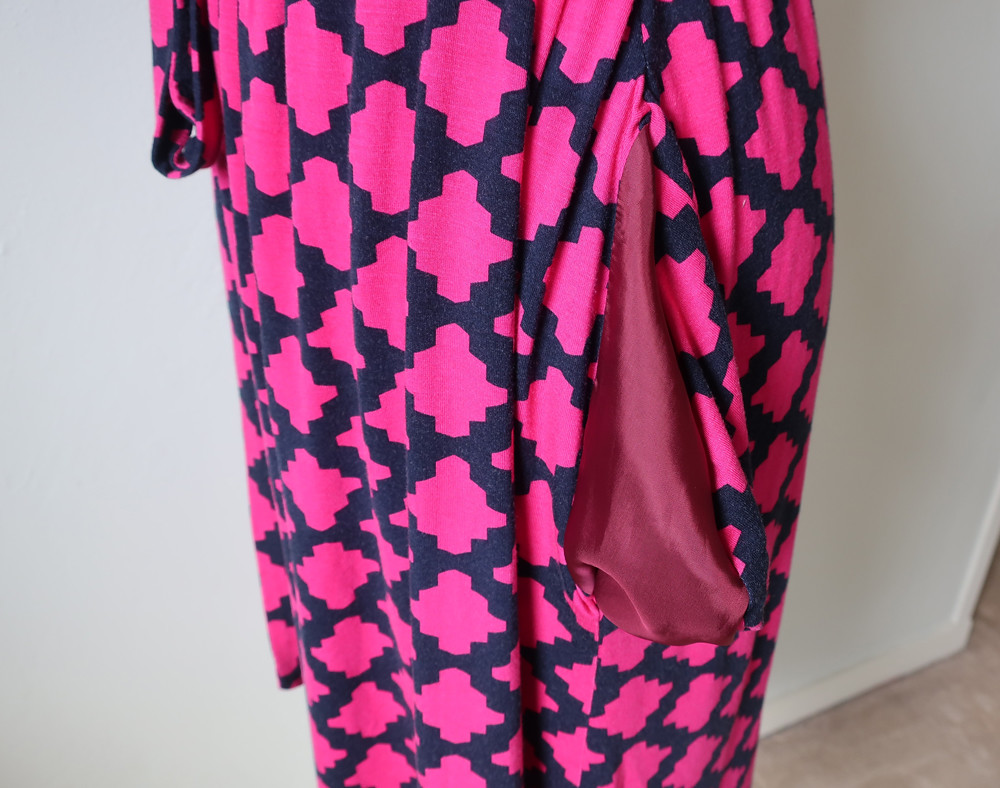
Let's talk inside finishing. I am far from a stickler about how things look on the inside, and I find using the serger to finish seams on knits completely useless. The fabric is never going to unravel and to me it just adds bulk and more steps in the sewing.

Yep - that's how I leave it. After this I did trim the seam allowances of the sleeves at the underarm but otherwise nothing else.
In all these pictures I must confess that my eye goes straight to the hem, where the skirt under layer is sticking out a bit below the top layer. So I'll have to fix that before I wear it out and about. It was actually freezing when I ran outside to take these pictures - and fussing about perfection was not in the cards. Thankfully spring has arrives since then and the weather is glorious. On the down side, I've had to start watering the plants - no spring rain for us and I think it will be another terribly dry summer.

When it comes to hems on knits I don't have a coverstitch machine and I've never found the twin needle thing to work for me. My go-to method for hems on knits is to put a small strip of fusible knit interfacing in the hem allowance, so that the machine stitching is going through both the fashion fabric as well as one layer of interfacing. This gives the hem just the right amount of weight and avoids the ripply situation you can get on knit hems. Then I hand stitched the corner so that nothing was sticking out below the hem edge.

So that's the scoop on this vintage Vogue pattern. I might even sew it up again, the sleeveless version is calling my name as well. Liking the longer length is something that surprised me, I usually don't make my dresses much past mid-knee as I think the longer length makes me look short but perhaps this works. I'll have to see how I like it with flat sandals.
Item # 2 of my quarantine sewing completed and documented. Up next, I finished a silk top from a New Look pattern that I saw somewhere and had to have. And then my denim blazer, almost done except for the buttonholes however that reveal will have to wait until I complete the jeans and have the full pantsuit. (having doubts about the outfit potential but will make the whole suit just for the fun of it).

I hope everyone is well and doing OK with the current situation. Stay safe and keep sewing!
Beth
Today's garden photo is this fantastic tulip - it's so dark and saturated in color. A nice surprise among the mystery tulip bulbs that were planted last fall.
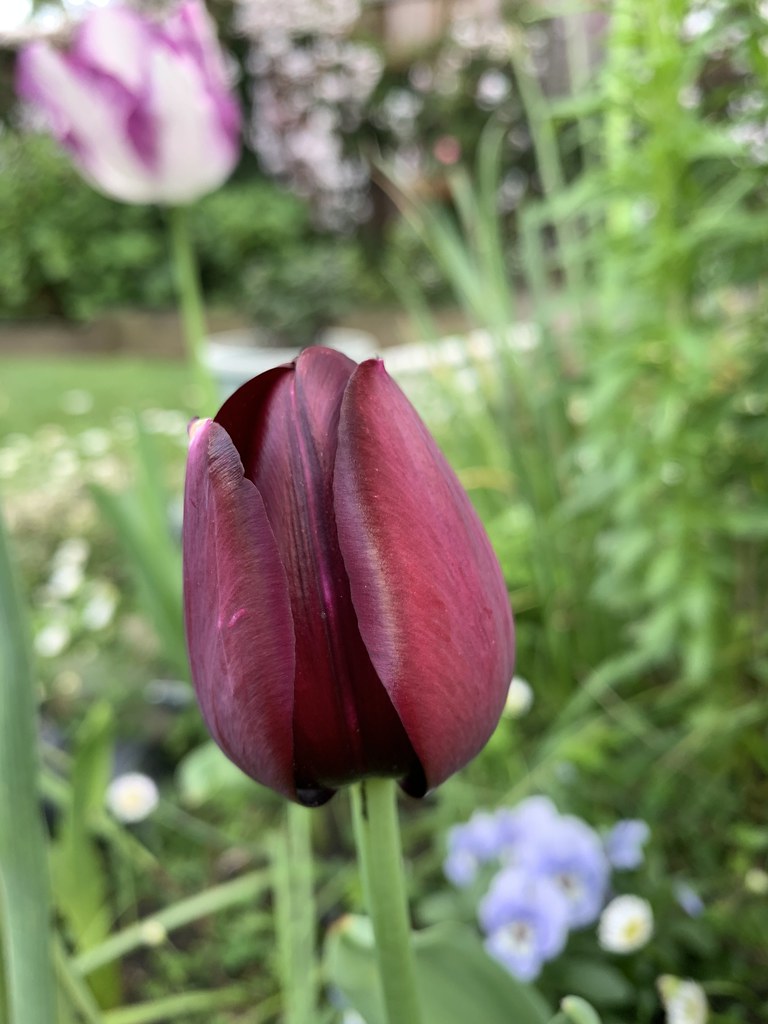









Gorgeous dress, could be one of the original DVF beauties! I know from experience that knits in the 70s were FAR different from today's knits. Most of them were cotton (sportswear) or polyester (business wear), or very slippery nylon fabrics for slinky disco dresses. The one thing they had in common was that they all had mechanical stretch, no fiber stretch - it was before Lycra was widely introduced and became a standard ingredient in apparel fabrics. I'm afraid back then I made a few knit tops that didn't stretch enough to pull on over my shoulders! Still, the lack of stretch gave the fabrics a lot of stability that in some ways made sewing easier.
ReplyDeleteLovely, and I think it lengthens you. Thank you for the tips on how you work best with knits, and the comparison to knits from the 70s, all very helpful. I have been stuck with more than a few knits with a silly amount of stretch. I am at a loss what to do with them. Just make tops, I guess.
ReplyDeleteBeautiful. I got married in 1977 and my bridesmaid's dresses ( all sewn by me or them) were polyester knit. I assure you they were firmer and less stretchy. Loved them because they didn't need to be ironed, and finished the hems with stretch lace, but the rest looked exactly like yours. No need to zig zag all around each piece. Your pattern was a deal, I looked and the lowest price I found was $37.50 and the top dollar one was $119. Yikes. If those patterns are so sought after, maybe because they were well drafted and had good instructions, I keep wondering why the companies don't just reissue them as printed originally. I love the front, not too low cut, and the sleeve style and length is very flattering too.
ReplyDeleteThis dress really has the WOW factor! So gorgeous on you. Perfect combination of fabric and pattern.
ReplyDeleteThat is a really great dress. I thought as soon as I saw the picture how becoming the length is. If I may say so, I tend to think - but how can one judge from photos? - that the dresses you make for yourself often look a bit out of proportion because they are too short. And that one is just so right! I love the colours - I am sure they look really good under your californian skies.
ReplyDeletethat is stunning, perfect fabric - and great tip on lining the bodice.....love it
ReplyDeleteThank you so much for this. I am about to make V1610 and was having doubts about the stretch fabric I've chosen for it. This blog has set me right and I'll follow your tips.
ReplyDeleteGoodness. I just learned so much from reading this blog. Thanks so much, lady!! It's beautiful!
ReplyDeleteLovely dress! It is always so useful to hear how you go about making a pattern, what you check for, etc. and many thanks for the tip about the stabilizing lining. I have a droopy dress in a gorgeous merino wool knit that i hate myself for ruining, maybe this is how I can salvage it.
ReplyDeleteIt's absolutely perfect! And what a great reminder about the power of / job of a lining.
ReplyDeleteYour dress is so lovely and looks great in that fabric.
ReplyDeleteLove your dress! Fabulous colors which suits you so well ♥
ReplyDeleteBeth I am just about to embark on one of these DvF dresses using a two-way stretch knit. I cannot find any if the knit you described (I'm in the UK) but do you think silk organza or, say, cotton batiste, or a light cotton could control the bodice and hold it stable? Your advice would be greatly appreciate, thank you.
ReplyDeleteHi Chris - I don't think any of those tightly woven fabrics would work as then the bodice would have no give. Also I find silk organza inside a garment but without a lining is very uncomfortable to wear.
DeleteI wonder if you tried the cotton batiste but put that on the bias, then it would have a moderate amount of stretch but not too much.
Thank you, Beth, I will give the batiste a try in the toile I will definitely be doing.
ReplyDeleteSuch a wonderfully simple fix to that unwanted stretch! It's a seriously gorgeous shape and colour on you, Beth. Love this dress!
ReplyDeleteOh my, this is a gorgeous dress, Beth. It's been awhile since I read some of my favorite blogs. You have made so many beautiful pieces.
ReplyDelete